Tail
Basic Tail Shapes
When looking at different tails, a good rule to remember is more angular shapes will give you more pivotal and sharper turns. A rounder shaped tail will give you rounder and smoother turns. Tail shape influences the hold and release on the surface of the wave. Picture how water flows off the back of the board. Water is sticky and follows the lines of the board. Curves hold water flow whereas corners allow water to break away. A round or pin tail will hold the water longer making it stable in bigger surf. A square or angular tail will release water making it looser, skatier and snappy.
Different shapes will change the width of the tail, which determines surface area. This will influence how your acceleration and how much control you have on the face of the waves.
Although there is a wide spectrum of tail shapes, most are variations of the following fundamental tail designs.
Basic Tail Shapes
Pin Tail
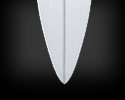 This is designed for maximum traction and control on the wave. Pin tails have the narrowest width of all the tails. Less width minimizes the tail's surface area allowing you to sink and dig into the water causing the board to track and maintain direction. Notice the shape is a straighter curved line that converges to a point, thus called the pin tail. This design gives you maximum water flow without any abrupt release for better hold. Pintails can be difficult to maneuver and are not ideal for small waves where tail surface area is needed for lift. That is why you typically find these pin tails on guns. When you're dropping into a large wave, tracking and control in high speeds is more important than maneuverability.
This is designed for maximum traction and control on the wave. Pin tails have the narrowest width of all the tails. Less width minimizes the tail's surface area allowing you to sink and dig into the water causing the board to track and maintain direction. Notice the shape is a straighter curved line that converges to a point, thus called the pin tail. This design gives you maximum water flow without any abrupt release for better hold. Pintails can be difficult to maneuver and are not ideal for small waves where tail surface area is needed for lift. That is why you typically find these pin tails on guns. When you're dropping into a large wave, tracking and control in high speeds is more important than maneuverability.
Round Tail
 This shape is similar to a pin tail because it allows water to wrap around its contour for better traction than the square tail in bigger, faster, hollow waves. It is more versatile with more width than the pin tail. The added width increases the surface area and results in more lift. More lift allows the board to be more loser and turnable than its pin tail counterpart. With the curve shape you should expect more round, drawn out turns and less sharper, pivotal turns than its square tail counterpart. The added surface area will also provide more speed in slow spots.
This shape is similar to a pin tail because it allows water to wrap around its contour for better traction than the square tail in bigger, faster, hollow waves. It is more versatile with more width than the pin tail. The added width increases the surface area and results in more lift. More lift allows the board to be more loser and turnable than its pin tail counterpart. With the curve shape you should expect more round, drawn out turns and less sharper, pivotal turns than its square tail counterpart. The added surface area will also provide more speed in slow spots.
Squash tail
 The most common tail among shortboards is a squash tail, which is a variation of the square tail. The square or edgier shape allows for quick release. This makes the board very responsive and easier for sharper and looser turns. The shape allows for more width, which increases the surface area in the tail. More surface area means more lift, or easier to plane and maintain speed. This will obviously come in handy in the slower spots of a wave. Less surface area will cause the tail to sink or bite into the wave, making it ideal for control and tracking in high speeds. The rounded ends give the board more hold than a hard edge square tail. A squash tail is very versatile as it is designed to give you better control in steeper and bigger waves as well as softer waves.
The most common tail among shortboards is a squash tail, which is a variation of the square tail. The square or edgier shape allows for quick release. This makes the board very responsive and easier for sharper and looser turns. The shape allows for more width, which increases the surface area in the tail. More surface area means more lift, or easier to plane and maintain speed. This will obviously come in handy in the slower spots of a wave. Less surface area will cause the tail to sink or bite into the wave, making it ideal for control and tracking in high speeds. The rounded ends give the board more hold than a hard edge square tail. A squash tail is very versatile as it is designed to give you better control in steeper and bigger waves as well as softer waves.
Swallow Tail
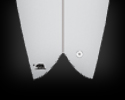 Notice the shape of a swallow tail resembles two miniature pin tails joined together side-by-side. Its design is similar to the pintail in that the two points will give the board more hold and traction. The upside down vee that is cut out of the tail allows for bite and control when the board is going in and out of turns. Notice the shape allows for a much wider tail and larger surface area, making it easier to maintain speeds in softer parts of the wave. This is more ideal for smaller waves, which is why a fish will typically have a very pronounced swallow tail. The wider and more pronounced the swallow tail, the stiffer it is in transition from rail to rail. When making radical changes in direction, the pin of one side has to disengage before the tail can reengage on the other pin to pivot.
Notice the shape of a swallow tail resembles two miniature pin tails joined together side-by-side. Its design is similar to the pintail in that the two points will give the board more hold and traction. The upside down vee that is cut out of the tail allows for bite and control when the board is going in and out of turns. Notice the shape allows for a much wider tail and larger surface area, making it easier to maintain speeds in softer parts of the wave. This is more ideal for smaller waves, which is why a fish will typically have a very pronounced swallow tail. The wider and more pronounced the swallow tail, the stiffer it is in transition from rail to rail. When making radical changes in direction, the pin of one side has to disengage before the tail can reengage on the other pin to pivot.
Square Tail
 The square tail is the earliest surfboard tail design and the parent of all other tail designs. The square tail is wide and helps ad stability to a surfboard. Because of the extra width in the tail though, the surfboard will have less curve in the rails. The corners of a square tail dig into a wave while turning and help increase the ability of a surfboard to make pivotal turns. You will most often see a square tail on a longboard, though some shortboards have a smaller version.
The square tail is the earliest surfboard tail design and the parent of all other tail designs. The square tail is wide and helps ad stability to a surfboard. Because of the extra width in the tail though, the surfboard will have less curve in the rails. The corners of a square tail dig into a wave while turning and help increase the ability of a surfboard to make pivotal turns. You will most often see a square tail on a longboard, though some shortboards have a smaller version.
Asymmetrical Tail
Recently there has been in increased popularity in creating asymmetrical surfboard tail designs. These are not really a different tail shape, but rather a way to combine two different tail shapes so a rider can have one template for front side riding and another for back side riding. For example, you might combine a fish tail on the right and squash tail on the left. For more information, check out the interview with the inventor of the asymmetrical surfboard tail.


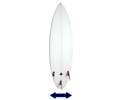
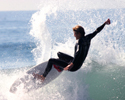


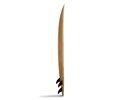

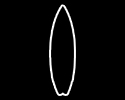


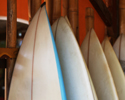
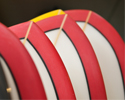
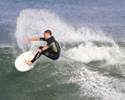
1 Comment